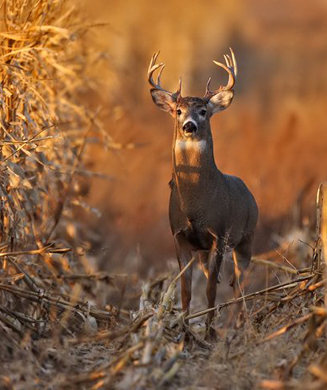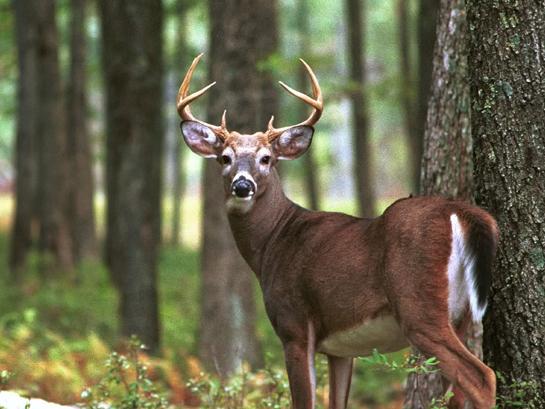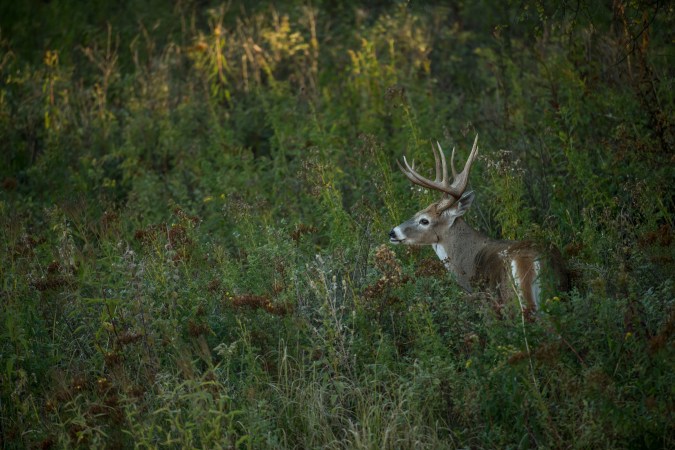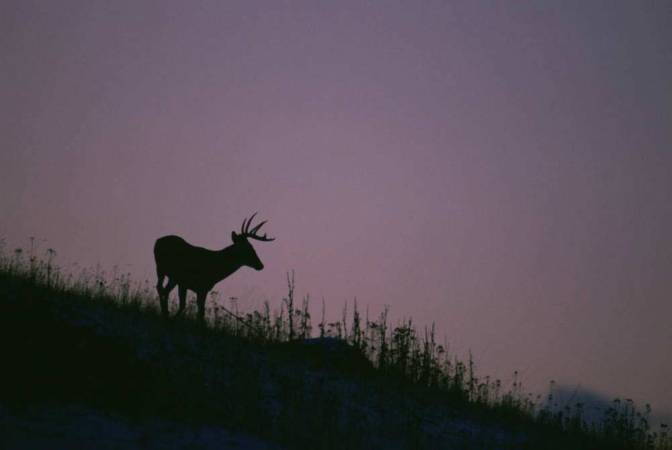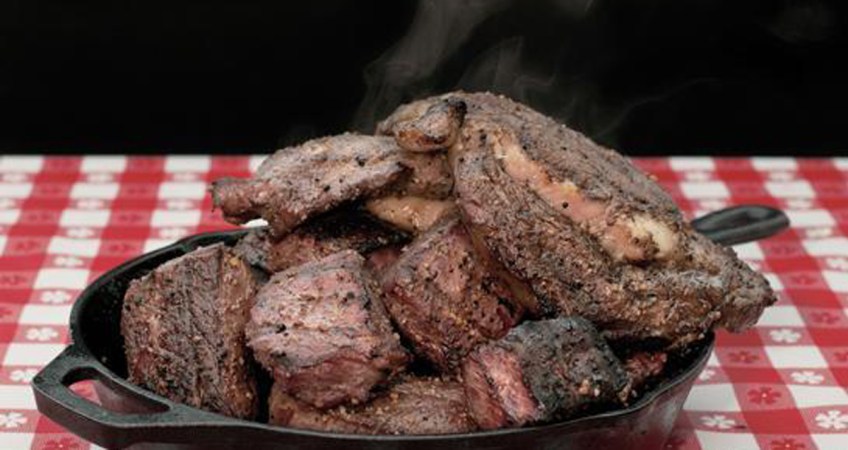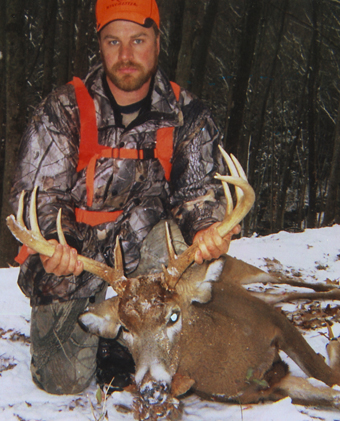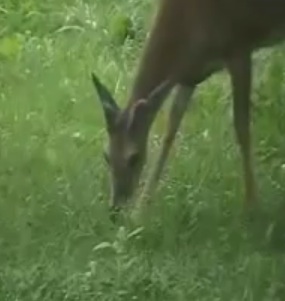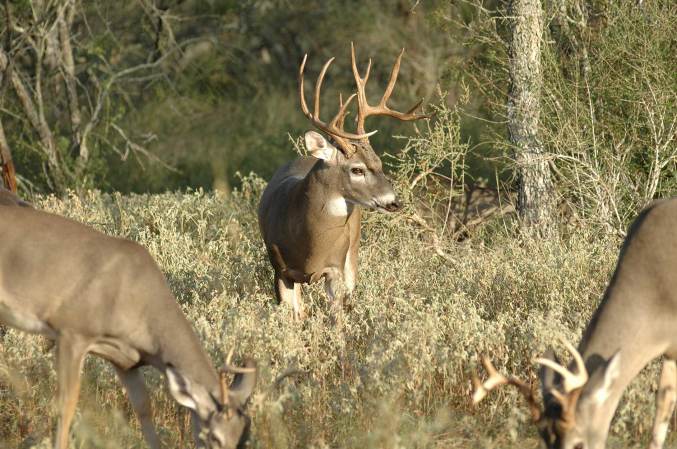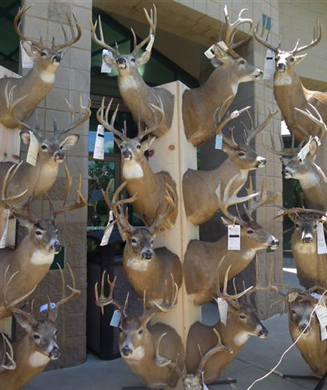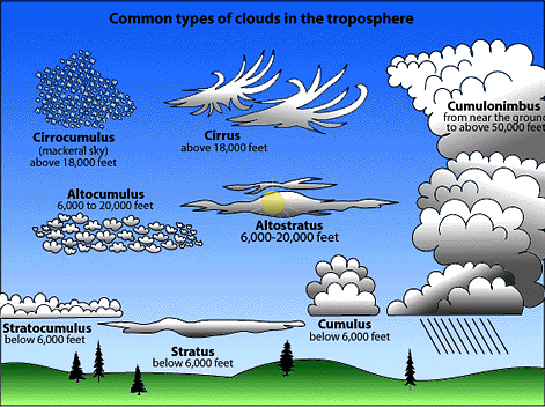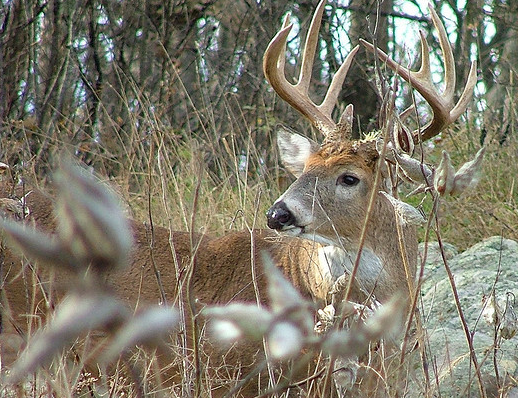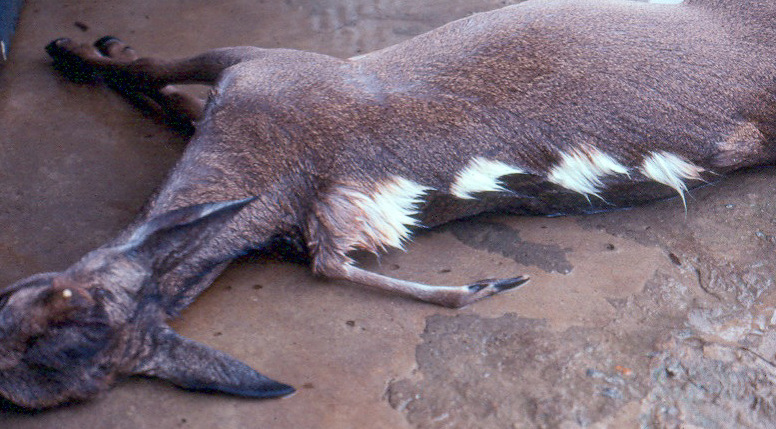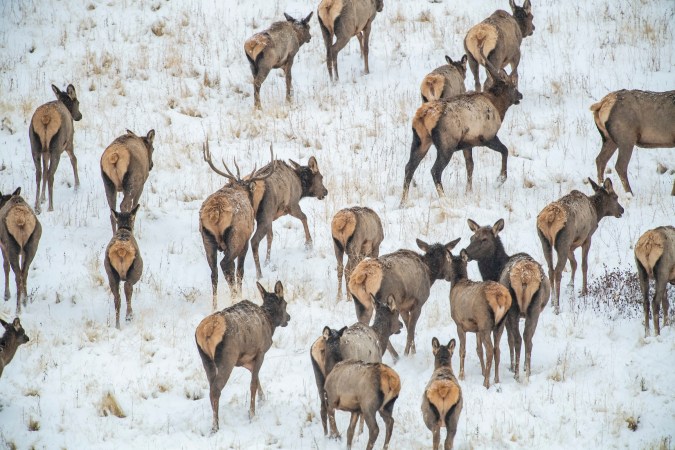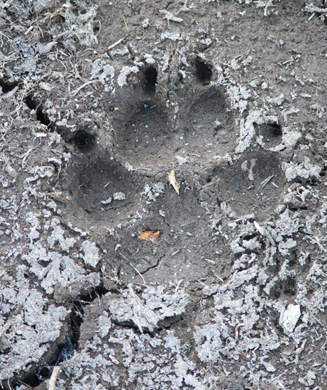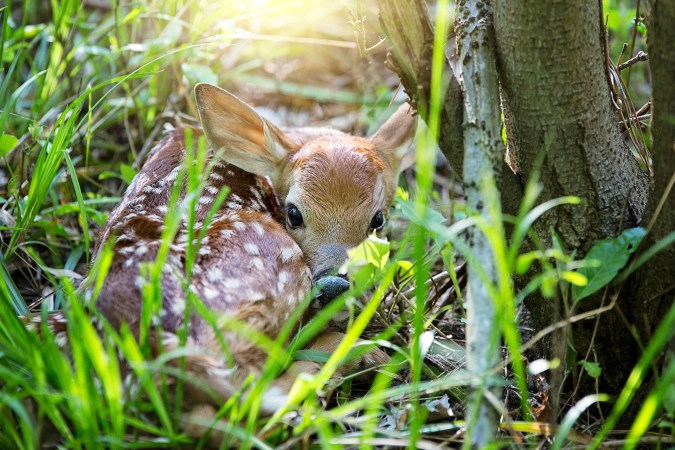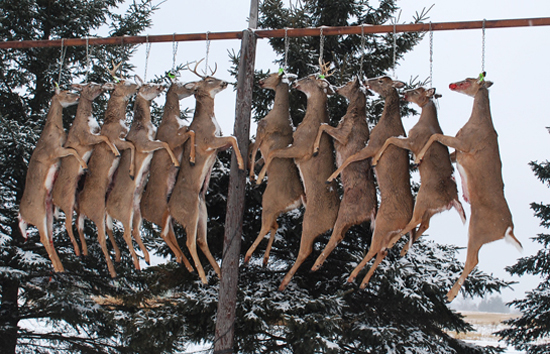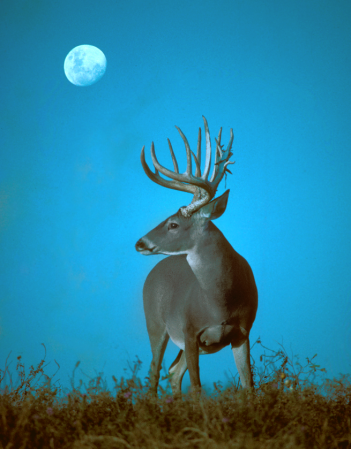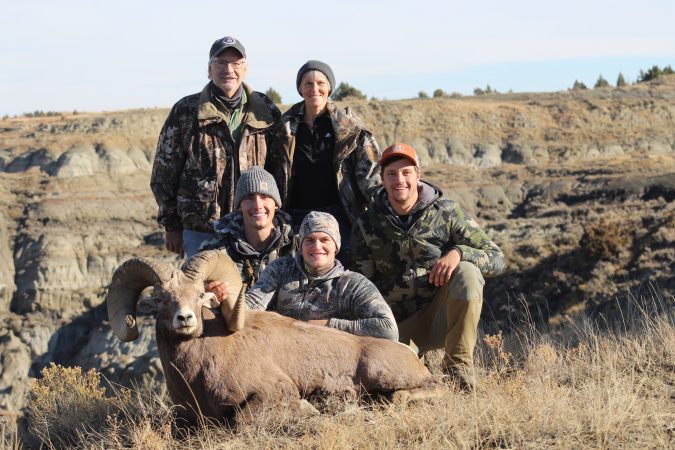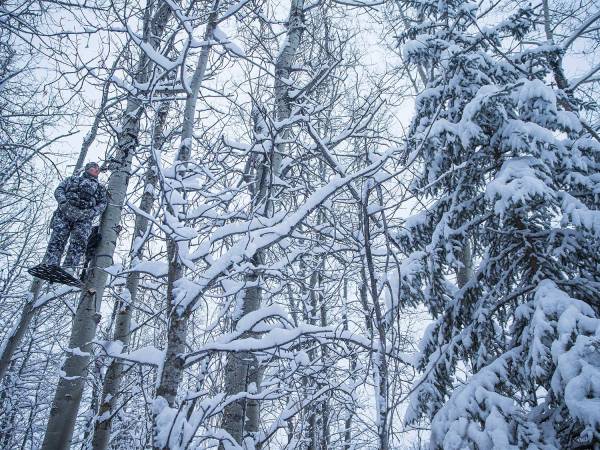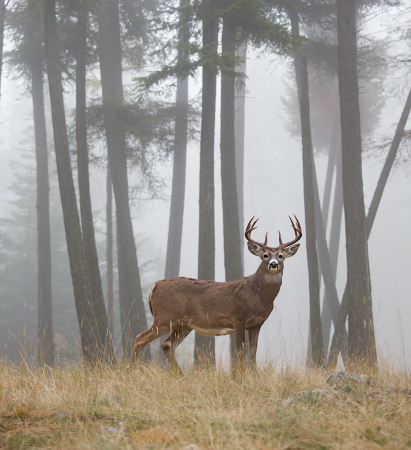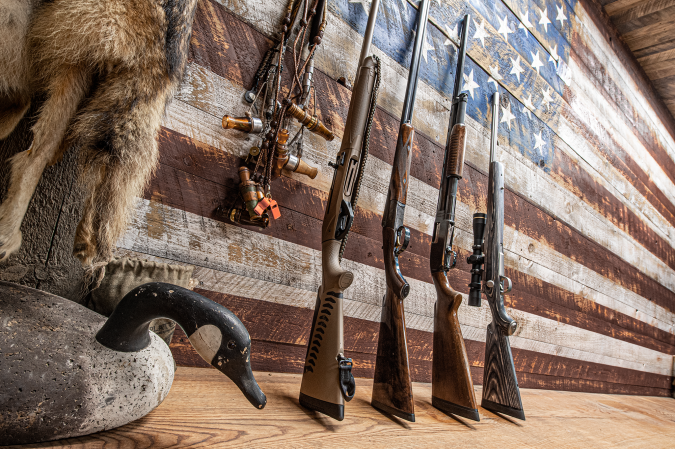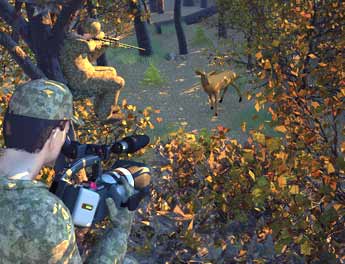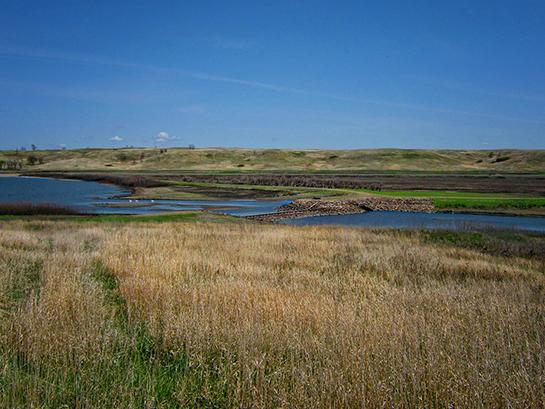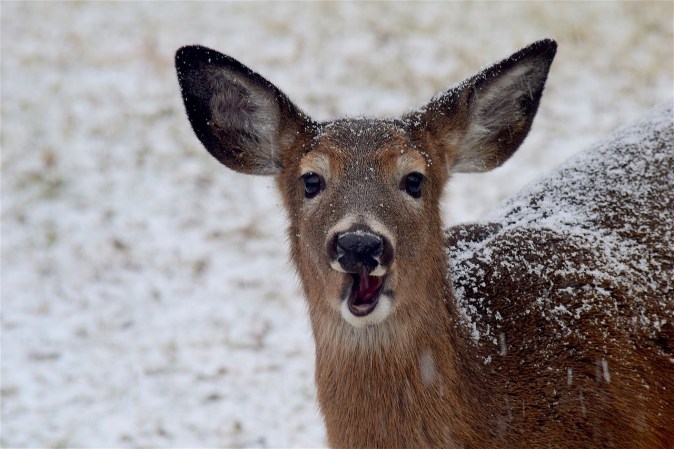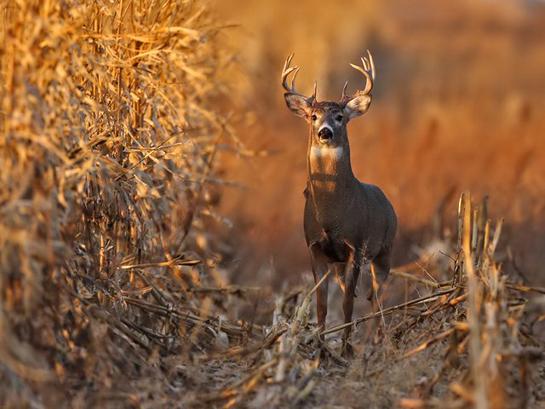
Editor’s Note: Outdoor Life writers are on assignment in Branson, Missouri for Quality Deer Management Association’s first-ever Whitetail Summit. Over the next two days, we’ll be reporting from the numerous break-out sessions to give you the inside-scoop on the issues most critical to deer hunters. Check back regularly as we update this live blog.
Thursday, 1:30 PM: A Hunter’s Perspective of the North American Deer Summit
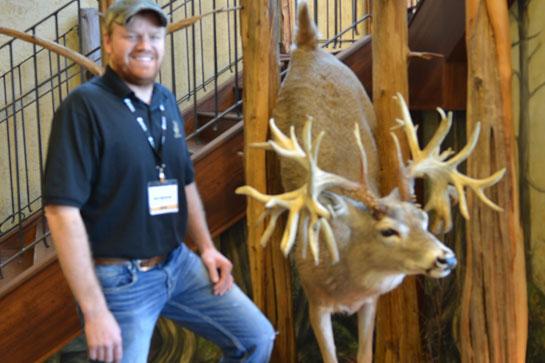
The majority of attendees at the North American Deer Summit had a professional stake in being there. State game biologists, industry manufactures, conservation organization leaders, outdoor media, and more make at least a portion of their living from work related to white-tailed deer. One group of attendees though, had no dog in the fight other than being deer hunters. Rob Muirhead was one of them.
Rob Muirhead is from Elm Creek, Neb., and he’s been deer hunting for 24 years. His uncle introduced to the sport that has become a life passion. He’s independently employed in the automotive paintless dent repair industry. Meaning, he fixes hail damage on vehicles. This profession allows him the flexibility to take deer hunting seriously.
Muirhead attended the Deer Summit because he wanted to learn the about the current state of the white-tailed deer from industry insiders and how to most effectively express his views to make an impact on the future of white-tailed deer hunting.
Why did you want to attend the North American Deer Summit?
The future matters to me. I have a daughter who I want to have deer and quality deer habitat. When she’s my age I also wanted to learn about how other state agencies are managing deer, because I’m not exactly thrilled with Nebraska. They’re getting better, but it’s not Iowa or Kansas.
QDMA has a two level deer steward course, and I’m unfortunately the only person I’m aware of in Nebraska to have completed the Deer Steward II course. I wish there were hundreds of us, because the program teaches localized conservation importance. The more educated conservationist we have on the ground, the better our habitat and deer herds will be collectively. I hoped to attend the Summit so I could take what I learned and use it to motivate others in my area to advance their own education and to become better land and deer managers.
What was your first reaction to the Deer Summit?
The broad variety of representation impressed me first off. I could tell right away that the people here weren’t just the top guns of the hunting industry. There were others just like me and we were able to speak right to many of the foremost decision makers in the industry. The opportunity to be part of something so important meant a lot.
What is something you learned at the Summit you were previously unaware of?
It’s really tough to form a cooperative or get others on board for QDM in my area. I think it’s the old traditions or way of thinking that things are the way they are and that’s how they are always going to be that stands in the way of progress. Not many people are interested in working to improve what they’re already comfortable with. I just want to help people understand that they may think things are good, but they could be great. I just have to keep working.
How do you plan to implement what you learned here?
I honestly think I contributed more than I learned, and I don’t say in a egotistical sort of way. I feel the hunters were really here to give our opinions and thoughts to the agencies and organization so they could implement our desires. The object was to get the hunters’ perspective of what we want changed and we were happy to give them that information. I feel great because I really feel like we as hunters we heard.
What was your overall impression of the Summit and what do you expect it will accomplish?
It was mind-blowing. The passion here from so many different stakeholders for improving the whitetail world as whole was beyond impressive. I hope and believe the Deer Summit created a more collective union of whitetail professionals and enthusiasts across the broad spectrum of folks who, like me, are obsessed with whitetails.
–Brandon Butler
Thursday, 10:45 AM: Unrealistic Expectations: A Product of Hunters or Marketing?
I love it when the truth is spoken.
And Jay McAninch, the CEO/President of the Archery Trade Association, just spoke it.
As part of the morning’s session on this final day of the North American Whitetail Summit, each stakeholder group is sharing its summary of top issues identified over the course of the event.
McAninch identified that hunter recruitment and retention was the most important issue facing deer hunting in the eyes of industry.
“When in an industry that requires a customer base to stay in business, we’re closer to the line of how hunter recruitment and retention affects us.”
In other words, without new hunters coming into the store, the industry folks will sell less product.
While that may not deliver the warm, fuzzy feeling one might expect when discussing hunter recruitment and retention issues, it is the stone-cold truth.
The second-most-important issue according to industry representatives was political influence – but perhaps not in the manner you’d expect.
“We have a whole lot of businesses that are terrified of what may or may not happen in regards to health care,” he said. “We have a tremendous number of small businesses in the hunting industry. And when they see the differences between 50 employees, 100 employees, the differences in the costs … it’s very, very scary to them. They have a lot of long-time employees that they value highly. This is a major concern.”
McAninch also touched on the subject of the commercialization of whitetails. And this is where the truth was delivered very clearly, for better or worse.
“We are very good at delivering a message and promoting a product,” he said. “The issue of creating unrealistic expectations (regarding the size of bucks hunters can realistically pursue) is harder to handle.
“You don’t see a lot of toothpaste companies saying their toothpase will make your teeth ‘good.’ They show this incredible white smile. When Rapala markets a lure, I’m pretty sure they’re not selling a great day on the lake. It’s the same with hunting. When guys are sitting in the woods, they are likely thinking ‘Maybe, just maybe.'”
McAninch is absolutely correct. And being 100 percent truthful.
As hunters, we have told companies to market to us in ways that are increasingly sensational and unrealistic.
Think about the products you buy, the advertising that catches your eye and spurs a purchase.
Are you likely to buy a deer call based on ads or packaging that illustrates the call’s effectiveness on pulling in 80-inch, 2-year-old bucks?
Would you buy a broadhead that claims to be “Hell on yearlings?”
Nope.
We want big bucks. Giant bucks. The kind of bucks, quite frankly, that simply don’t exist in much of whitetail country.
Companies must sell products to survive. And they are giving us exactly what we want.
So who is really at fault for creating this era of unrealistic expectations?
Us or them?
–Tony Hansen
Wednesday, 1:20 PM: Hunters’ Perspectives Tend Toward Access, Recruitment/Retention, Invasive Species, and Political Influence
What are America’s deer hunters thinking about? What are their biggest worries and opportunities?
Land access, the erosion of political influence of hunters, invasive plant and animal species, and ineffective outreach and public education.
There are a lot of other topics, but these were identified as leading issues by the 50 or so hunters who are attending the Whitetail Summit this week. It’s important to note that this isn’t a statistically reliable cross-section of hunters. These are invested, motivated, avid deer hunters who had the time, funds, and motivation to get to Branson to participate in the summit. That’s a tiny fraction of deer hunters, most of whom don’t have the resources to participate.
And while many of these folks identify themselves as hunters, they bridge many of the seven interest groups at the summit. Folks in the hunting group are also landowners, educators, members of conservation groups, and even the media.
In no particular order, here are some revealing comments and perspectives that came out of today’s session:
POLITICAL INFLUENCE
– There’s a pervasive feeling that hunters have a disproportionately weak voice in our political system. One way to boost our influence may be to create a super-PAC of hunters – not unlike the way the NRA represents America’s gun owners. This could be a coalition of conservation groups – combining Ducks Unlimited with the Quality Deer Management Association with the Rocky Mountain Elk Foundation with the National Wild Turkey Federation.
– We hunters need to do a better job of collaborating with other groups that share many of our interests, with the Farm Bureau on property rights, for instance, or the Nature Conservancy on issues of landscape health.
LAND/HUNTER ACCESS
– In many places, the only tool landowners have to manage local deer herds is access – or rather, limiting access. Consortiums of landowners are trying to counter this by forming deer-management cooperatives, and providing access is one tool that these cooperatives use to keep the deer herd in balance with the habitat.
– Hunters must do a better job of recognizing that access has a cost, and a responsibility. Hunters need to reach out to landowners, offering to help with physical work on the property, and they need to better conform to the deer-management objectives of landowners who provide access.
– There is a keen interest in developing a tax break or other incentives for landowners who provide hunting/recreational access.
– And lastly, state-issued antlerless tags that focus hunting pressure on properties with too many deer should have an access provision, basically linking landowners with an interest in removing deer with hunters looking for a place to hunt.
RECRUITMENT/RETENTION
– One of the liveliest discussions centered on the ways we are — and are not — attracting and keeping a new population of hunters. As one participant noted, “Does anyone else notice a significant racial bias among hunters? Look around. We are almost universally white, older, and male.” Introducing hunting to other demographics is key to preserving our ability to hunt into the future.
– The other notion that got heads nodding was the recognition that just as hunters are trending older, so are those of us reach out to new hunters. Our Hunter Education instructors are aging and largely out of touch with new delivery mechanisms like the internet and Facebook, and may be obstacles to reaching new, digital-age hunters.
– We may be ruining beginning hunters by forcing them to become deer hunters. Instead, we should be encouraging squirrel hunting and fishing, activities with high activity and success rates that can capture interest in the outdoors immediately. An addendum to this was the consensus that mentored hunting stops short. A mentor to a new hunter should engage the new hunter year-round, and in various outdoor experiences.
EDUCATION/OUTREACH
– We hunters need to do a much better job of reaching out to the 79 percent of American’s who don’t hunt, but who support hunting. We hunters do a good job of educating ourselves, but when’s the last time we talked to a non-hunter about all the good we do for the land and our culture? We conserve resources, we provide healthy wild meat for our families and neighbors (1.2 billion meals per year!) and more than any other group, we pay for our recreation.
– And we need to do a better job of communicating between groups: between state agencies and hunters, between various species-specific conservation groups, and between factions of hunters.
INVASIVE SPECIES
– Taken together — invasive plants, non-native predators, and invasive animals like hogs and feral cats — America’s hunters are facing a noxious mix of threats that may combine to create very real problems with wildlife habitat and our ability to manage our wildlife populations in the coming decades.
– We can’t wait to address things like the creeping spread of invasive plants like autumn olive, multiflora rose and honeysuckle or the spread of wild hogs. If we do, we could be staring at “biological deserts” in the near future.
– States with recent influxes of coyotes –mainly in the Southeast — need to recognize the impact of the predators and re-evaluate harvest objectives in the context of the additional mortality.
–Andrew McKean
Wednesday, 11:30 AM: Will Primos: The Delivery Man
Will Primos sold the famous hunting products company bearing his name back in 2006. That hasn’t slowed him down. In fact, stepping away from the day-to-day operations of running Primos has allowed Will to focus on what matters most to him: advocating for hunting.
“You know, George Strait is the greatest country music artist of all time, at least in regards to number one records. But George Strait has never written his own songs. Where he excels is at delivering the message. It’s the same thing in our industry. Once we figure out the message, we have to find the people who can deliver the message. Figuring out the message is what we are doing here at the Deer Summit. When we leave here, we have to get the message out,” he said.
Hunting is diverse. And Primos ran a diverse hunting company. His first love was waterfowl. He also developed and sold turkey, predator, elk and other calls. But Primos knows what buttered his bread.
“Whitetails are number one, by far. Look, there are more deer hunters than all other hunters combined, so the opportunity to come up with products that aid and benefit the deer hunter is greater. For instance, right now, trail cameras are the number one market category for deer hunters. They’re a relatively new technology. Coming up with deer hunting products is the most economically important aspect of Primos’ business, and the business of most hunting industry companies,” he said.
Primos believes the future of whitetail deer hunting is bright, but change is going to happen and must happen for deer hunting to continue to grow and thrive.
“The future of whitetail deer hunting has great potential, but it’s different in different parts of the country. We need to come together to have a holistic program for the entire U.S. That’s where QDMA is so powerful. We need to decide what we want whitetail deer hunting to look like in the future. We need to act on disease issues and private pen issues. We need to protect our traditions, but expand our thinking to accept what has to happen to ensure the future,” he said.
Whatever the message ends up being, whatever we collectively come up with here at the Deer Summit, Primos is committed to using his skills as a “delivery man” to make sure it reaches the public.
“Hunting is a sport, and I say sport, because you don’t have to go out and kill your own food in this time we live in. But there is a huge population of hunters who understand the power in putting your own food on the table. They understand how to utilize what God has given us to feed our families. It helps balance the herds, too. And hunting brings families to together. The bonds created in hunting camps, the time with mom and dad in blind, and learning about nature, it’s a pretty cool,” Primos said.
–Brandon Butler
Wednesday, 10:15 AM: Deer hunters Suffer by Neglect of “Animal Planet” Biologists
Do you know the name of your local fish-and-game biologist? How about his or her boss?
Chances are that, even though you are a hard-core deer hunter and your hunting license fees fund your state wildlife agency, the familiarity isn’t mutual. But the communication gap may not be intentional. It could be that your local deer biologist just doesn’t understand deer hunters. Or deer hunting.
That’s the conclusion of Dr. David Guynn, professor emeritus of wildlife management at Clemson University, who told attendees at the Whitetail Summit that the lack of university-trained deer biologists is one of the threats facing deer hunters and deer hunting.
“What do we want in a deer biologist?” Dr. Guynn asked attendees, many of them state-agency biologists. “We expect a basic understanding of ecology, the knowledge of how to manage populations and habitats, and the ability to communicate effectively. And we want a passion for deer hunting and deer management.”
Then Dr. Guynn paused.
“And without those last two, I don’t think the others matter.”
But in the last 20 years, as universities have become less interested in training vocational grad students than in attracting income-generating researchers, and as a new generation of students whose main context for wildlife and the outdoors come from television and Hollywood is getting hired by state game agencies, the old-school deer biologist is a minority.
That’s the biologist who grew up hunting, and who talk as easily about favorite deer rifles as about antler-point restrictions and forage preferences.
“Thirty or forty years ago, land-grand universities wildlife programs stressed applied knowledge. In the last two decades, we’ve seen a shift toward ecology and conservation biology,” says Dr. Guynn. “State agencies are still on the applied side, but federal agencies are trending toward ecology.”
In part, this shift is natural. Our earlier generation of wildlife biologists was focused on restoration of game species. Much of that work accomplished, the focus now is on non-game species and scale issues. Scale, meaning less attention on population dynamics and more attention on DNA mapping and genetics.
Instruction changed from population dynamics and sustainable harvest to landscape ecology, conservation genetics, and Global Information System mapping.
But the biggest change has been in the background and expectation of both professors and their students.
“The typical student in a Masters-track wildlife program now is mainly from urban/suburban background, and most of their outdoor experience is gained through TV and the Internet. They have a poor understanding of wildlife population dynamics and habitat. And they have little direct exposure to hunting or shooting. This is the ‘Animal Planet’ generation.”
These students are interested in threatened and endangered species, zoos, and non-profit conservation, not necessarily with the biology of hook-and-bullet species. And many of them are angling not for state-agency jobs, but for employment as private-land consultants, which is perceived as a job segment with fewer headaches and more higher incomes.
And Dr. Guynn noted that universities themselves operate on a different model than they did a generation ago.
“I wouldn’t want to be a new professor these days,” he says. “Professors are viewed as profit centers. They don’t focus as much on raw education or teaching, but rather in research that will generate patents and royalties for the institution.”
There are some efforts to counteract this. Dr. Guynn noted that the Quality Deer Management Association has funded fellowships for its Deer Steward courses and has supported university research. The Boone and Crockett Club’s university affiliation program funds graduate-level research on wildlife issues, with a focus on huntable species, and the Max McGraw Wildlife Foundation and Wildlife Management Institute offer workshop for students who have never hunted.
“These are 4-day workshops, all expenses paid,” says Dr. Guynn. “To date, 42 universities have participated. Students shoot, and they can hunt if they want to.”
And, based on that experience, they become better deer managers.
–Andrew McKean
Wednesday, 10:00 AM: State of the Whitetail
There are nearly four times as many deer hunters as there are hunters chasing the next closest species in the U.S. Turkey hunters come in a distant second. This means deer hunters dominate the hunting culture.
Nearly 6 million whitetails were killed in 2012. Those deer resulted in 1.2 billion healthy meals for hunters, their family and friends, and needy Americans around the country. These hunters also inject billions of dollars into the U.S. economy. Deer hunters are contributing the most funds to the wildlife conservation coffer.
In many ways, deer hunting trends are changing. One of those trends we are seeing that is alarming a lot of hunters right now is a reduction in deer killed in many states. Especially in the prime Midwestern deer hunting states.
Iowa’s deer harvest has declined for eight straight years. In 2013, Indiana’s deer harvest was down more than 10,000 from 2012. Missouri was down more than 50,000. So what’s going on? Are there fewer deer?
“In some areas, for sure,” Kip Adams said. “But the sky isn’t falling. There are a number of issues going on.”
Disease, fewer hunters, lack of access, and an overall declining interest in hunting by U.S. youth are all well-known factors playing to the decline of deer killed. Also, many states have been actively trying to reduce deer numbers. The number of deer hunters want and what the landscape can support aren’t often the same. Many state management plans are working, and hunters are now noticing it.
A collective attitude change amongst hunters also contributes. In 2012, 37 percent of bucks harvest were 1 ½ year olds. This was the lowest percentage of 1 ½ years old killed ever. In 1989, 62 percent of bucks killed were 1 1/2. Harvest trends are changing as more and more hunters are letting immature bucks walk, thus not filling their tag.
More than 32 percent of harvested bucks were at least 3 ½ years old. More hunters are holding out for trophy bucks, and filling their freezers with does. Three regions of the country killed more than 3.1 million does in 2012. The question then becomes: Are we killing too many does?
Balancing hunter satisfaction and landscape conservation is tough. If you’re noticing a significant reduction in whitetail numbers in your area, then there are likely a number of factors at work.
–Brandon Butler
Tuesday, 6:05 PM: Finally, “The” Question Has Been Asked
Throughout the opening day of the North American Whitetail Summit, presenters gave overview-level presentations on nine pre-identified issues of importance according to the Quality Deer Management Association. Those were:
1. Hunter/Land Access
2. Political Influences
3. Declining Agency Budgets
4. Urban Deer Management
5. Hunter Recruitment/Retention
6. Landscape/Habitat Change
7. Captive Cervids
8. Diseases
9. Lack of University-trained Biologists
To wrap up the day, a pair of facilitators are allowing attendees to identify those critical deer management issues that have been missed to help focus tomorrow’s in-depth conversations.
And it took almost no time for the conversation to address the proverbial elephant in the room.
Craig Dougherty, a noted deer manager from the Northeast and OL’s whitetail blogger, put it pretty plainly:
“I’ve just been at the SHOT Show and the Archery Trade Association Show and the buzz at the shows was loud and clear: Why are we seeing such a decline in harvest totals across the country? What has happened?”
As a deer hunter, I was somewhat surprised this particular issue hadn’t already been addressed. But, admittedly, I arrived late to this party because of travel issues. And I assumed that I had likely missed that part of the conversation.
I hadn’t. Not explicitly.
After all, it was my understanding that this event was geared around that very issue: Something seems to be happening to our deer populations from coast to coast. Why?
As I scan around the room here, I see perhaps the greatest collection of whitetail-focused minds I’ll ever be part of.
There’s QDMA biologist Kip Adams, deer management guru Grant Woods, noted deer researcher Karl Miller, Quality Whitetails Editor Lindsay Thomas, Jr., dozens of state wildlife biologists. The list goes long and deep.
If there was ever a forum to discuss “the” issue — whether it is real or perceived — it is here and now.
The discussion throughout the day has been solid. But I must be honest here: I was already aware of most of the issues being discussed. Many of them have been issues for quite some time (I realize I’m supposed to be aware of those issues, and it’s my job).
But too many hunters are saying the same thing: Something is happening with our deer populations.
Harvest numbers are down. in some states, they are alarmingly down.
As important as the topics of disease and urban deer management and access are, we have already had those conversations. They are not unimportant and I certainly don’t mean to insinuate that they aren’t.
But the deer hunters of America have one question … and Craig Dougherty just asked it.
–Tony Hansen
Tuesday, 5:00 PM: Captive Whitetail Industry is a Huge Threat
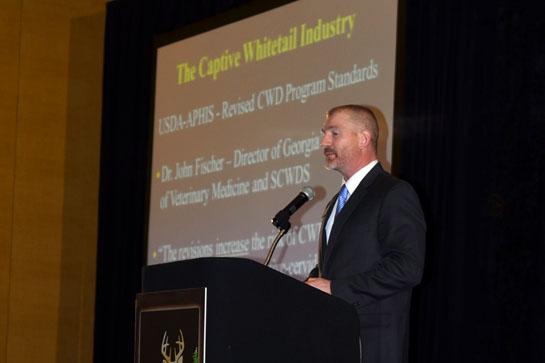
Across America, the high-fence deer hunting debate rages on. The small population of “shooters” who can afford to kill genetically mutated mega-bucks grown in pens try to defend their style of “hunting.” Those folks don’t have many allies here at the summit.
But the majority of folks here aren’t mad about what you might think. It’s not the shooting deer in a pen issue that’s of greatest concern. It’s the spread of disease, especially Chronic Wasting Disease (CWD), that has everyone worried.
Kip Adams, a QDMA biologist, says captive deer are the biggest threat facing wild whitetails today.
“In Iowa, the first seven cases of CWD were related to captive deer and the first case came from a deer shot two hours after stepping off a truck,” Adams said.
CWD was discovered in 2002 in Wisconsin, making it the first state east of Mississippi to discover CWD. They wiped out massive populations of deer trying to eliminate the disease. Their efforts failed. Wisconsin is no longer in the disease management business, they are now disease monitoring business. There’s nothing they can do at this point.
“Every deer that gets CWD is going to die,” Adams said.
The top five captive deer facility states are all CWD states. Coincidence? What do you think?
–Brandon Butler
Tuesday, 4:45 PM: Urban Sprawl Demands Better Land Management
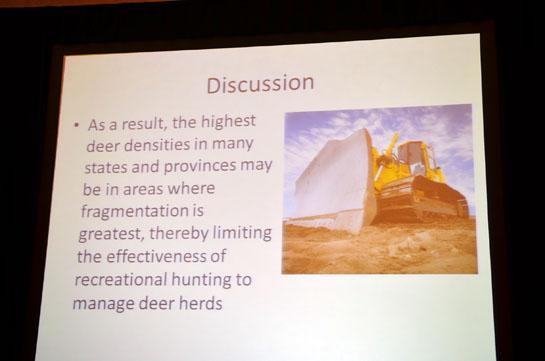
Deer hunting is constantly changing. Seasons, rules, regulations, populations; all of these change regularly. How we deal with change determines the future of whitetails, their habitat and hunting them. Private-owner land management is an essential piece of the puzzle.
“Change is a part of life. As we sit in this room our landscape is changing. Whitetails are changing,” said Matt Ross of QDMA.
The landscape of our country is becoming more developed. We have more roads which give greater access to previously remote areas. This changes how we manage land and wildlife.
“Human encroachment and fragmentation limit our ability to manage land, and thus limit our ability to manage deer,” Ross said.
When land becomes more developed, methods and regulations change. When you’re hunting 40-acres, you’re not going to track deer. You’re limited to sitting in a stand or blind. With higher human populations, firearms hunting may become outlawed, leaving bows as the only hunting tool. Bow hunters don’t kill as many deer as gun hunters, so deer populations grow. Then what? Sharp shooters, trapping, chemical suppression all become possibilities. All bad stuff.
Slowing down human progress isn’t likely. Unfortunately, more and more lands are going to give way to shopping malls, housing development, and general urban sprawl.
This means protecting and properly managing your own land is vital to conservation.
–Brandon Butler
Tuesday, 4:15 PM: How Gibson Guitars Might Impact The Future of Deer Hunting
Thanks to the “joys” of air travel in the midst of the polar vortex, I had the always-awkward task of trying to slip into a packed conference room at the QDMA North American Whitetail Summit in the middle of a presentation.
The first words I heard had me wondering if maybe the airlines had not only screwed up two days of travel with delays and cancellations, but maybe they’d dropped me off at the wrong damn place.
“The Gibson guitars case has cast a lot of attention on the law.”
After looking around and seeing a few familiar faces, I confirmed I was in the right spot. And it was time to figure out what, exactly, Gibson guitars had to do with whitetails. And what law was in question?
Well, turns out the law is one of vital importance to whitetails – and all of North America’s wildlife species, the Lacey Act.
In August of 2012, the U.S. Department of Justice reached a criminal enforcement agreement with Gibson Guitar Corp. after the company was found to be importing large quantities of wood from Madagascar and India.
The Lacey Act is a 1900 United States law that bans trafficking in illegal wildlife. In 2008, the Act was amended to include plants and plant products, such as timber and paper.
About the same time that the Lacey Act was being amended, the growth of captive cervid facilities (commercial deer and elk farms) was skyrocketing.
Carter Smith, with the Texas Parks and Wildlife Department, was the guy who brought up the Gibson guitar case and his point was this:
“Deer breeding and farming has grown to be a $3.6 billion industry and about $1 billion of that is in Texas,” he said. “A lot of people see it as a way to keep farmers in business. And maybe it is. But at what cost? We are seeing an assault on the Lacey Act because of the prosecution of Gibson guitars.”
The second tenet of the North American model of wildlife conservation prohibits the commercial sale of wildlife. The North American Model has been credited often for the protection, enhancement and long-term sustainability of wildlife populations in the United States.
But what happens if and when the Lacey Act is relaxed? Will it become easier to utilize wildlife for commercial purposes? Are deer held within a fence livestock or wildlife?
If we travel down the road of erosion of the North American Model’s second tenet, will we become more accepting of “farming” species most commonly known as wildlife?
Will we see an increasing number of captive cervid operations – operations that are largely believed to have been the root cause for diseases such as Chronic Wasting Disease and Bovine Tuberculosis?
And what kind of message are we sending if, in the name of “progress,” we ease restrictions that enforce one of the primary tenets of the North American Model?
“Imagine that,” Smith said. “The Lacey Act being heralded as over-regulation, over-criminalization.”
–Tony Hansen
Tuesday, 4:10 PM: Here’s Johnny
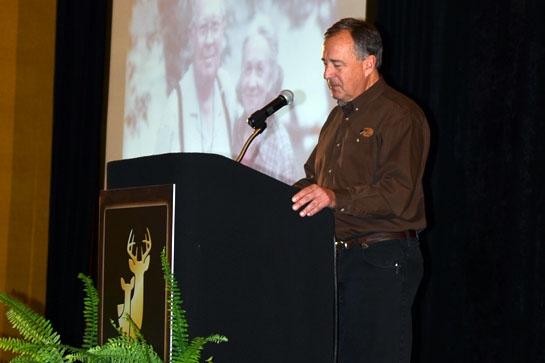
Johnny Morris, founder of Bass Pro Shops walks into the main banquet room of Big Cedar Lodge, the enormous, rustic yet elegant resort he owns on Table Rock Lake that is the host facility of the North America Whitetail Summit, and what’s on the jumbo screens? A gigantic Cabela’s logo.
“That’s alright,” Morris said. “When it comes to conservation, there’s no such thing as competition. We’re all in the same boat.”
This simple statement is perhaps the truest we’ll hear during the entire summit.
“Hunters are passionate conservationists,” Morris said.
Morris hasn’t always been the owner of a billion dollar business. In fact, he started Bass Pro from nothing in the corner of liquor store. His parents grew up without running water or electricity. Morris is a fisherman, hunter and conservationist first. He’s has been successful in business and he knows how fortunate he is.
“I’m blessed that my passion for fishing became a way for me to make a living,” Morris said.
His father once told him, “John, when I was growing up, I didn’t see any whitetails or turkey.” Morris has never forgotten those words, and his actions have aggressively supported making sure future generations will continue to experience today’s abundance of fish and wildlife.
“I have traveled to many other countries. I’ve seen what conservation is like in communist countries. Our North American model of conservation is the envy of the world. Nothing else comes close,” he said.
Morris concluded his speech by saying, “To accomplish great things in conservation it takes team work. It takes state agencies and business and media, and even Cabela’s.”
–Brandon Butler
Tuesday, 3:45 PM: American Deer Hunting is at a “Crossroads”
“Whitetail deer hunters and whitetail deer managers are at a crossroads,” says Brian Murphy, the CEO of the Quality Deer Management Association. That’s how he framed his comments opening the general meeting of the first-ever North American Whitetail Summit.
“We face more significant challenges than we’ve faced since the (wildlife) restoration era.”
That’s the reason we — a couple hundred deer biologists from various state agencies, representatives from corporate land holders, industry professionals, and non-profit groups devoted to hunting and wildlife management — are here this week in Branson, Missouri: to identify and start to address these challenges.
Among the issues Murphy noted: more frequent and severe EHD outbreaks across whitetail country, the vexing spread of Chronic Wasting Disease, increased fawn mortality (mainly by the teeth and claws of predators), lack of hunting access, intolerance of deer (and sometimes hunters) by landowners, non-hunters, and even changes in land use from coast to coast.
“There’s more concern and anxiety among the American deer hunter than we’ve ever seen,” says Murphy, who is one of the catalysts for this summit.
But Murphy noted that all this “anxiety” occurs in a context. For starters, the decline we’ve seen over the last decade comes from what have probably been unsustainable highs in whitetail populations and distributions.
“It’s important to note that I am not saying that whitetails are disappearing. But what I am saying is that they are down 10, 20, even 30 percent from their recent highs,” says Murphy. “How we address these issues will dictate what hunting and deer management will look like in the years to come.”
–Andrew McKean
Tuesday, 3:30 PM: Managing and Hunting Deer in Urban Landscapes
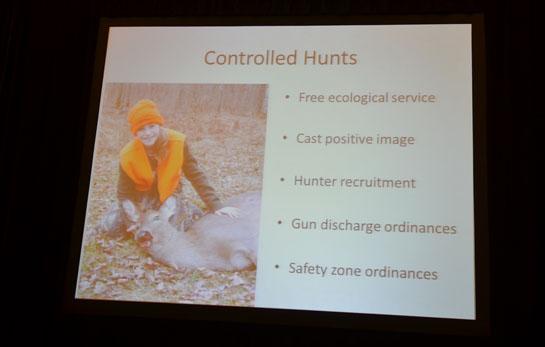
The majority of the U.S. population lives in urban areas. Figuring out how to manage deer in these urban areas is a challenge.
Hunters help with this.
Marrett Grund of the Minnesota Department of Natural Resources said: “Controlled hunts can cast a positive image on deer hunters.”
Controlled hunts offer a free ecological service to the public, as opposed to other scientific means of removing deer. They also help recruit hunters who may not have access to rural private land. Since many controlled hunts take place inside city limits, they are bowhunting only. Because there are no gun shots, the public rarely experiences a negative impact from a controlled hunt.
Controlled hunts also benefit hunters who are looking for additional tags. In many states, controlled hunt bag limits fall outside the realm of normal deer license parameters. For example, in Indiana hunters can kill only one antlered buck during the regular seasons, but can kill an extra buck in an Urban Zone.
–Brandon Butler
Tuesday, 3:15 PM: Politics and Money … Two Thing to Get You Fired Quick
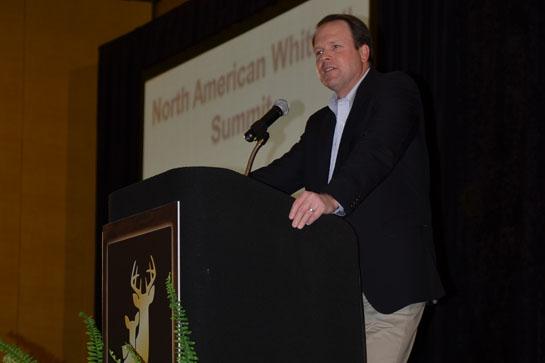
Carter Smith, Director of Texas Parks and Wildlife, says he’s been around just long enough to know that when a politician starts a conversation off by calling you “son,” the conversation is going to go downhill fast.
This happened to Smith when a politician told him once that the only kind of science he cared about was political science, and told Smith he better fix a problem that was causing an uproar amongst Texas bowhunters.
“Politics have always been and will continue to be part of deer management. The questions is, will hunters remain a strong voice of reason or will we be snubbed out by backroom legislative deals?” Smith said.
Smith said a politician once told to him, “It takes two things to be successful in politics; money and I can’t remember the other.”
Hunters generate money. Because of that, we matter to politicians. We also vote. So, let the guys running the show know your thoughts.
–Brandon Butler
Tuesday, 2:30 PM: Public Attitudes Toward Deer Hunting and Management
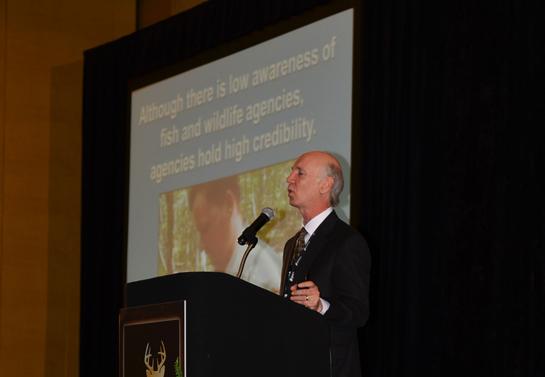
In 1943, Aldo Leopold said game management is easy, it’s human management that’s difficult.
Mark Duda of Responsive Game Management studies human behavior toward hunting. He started his presentation at the Deer Summit off by saying, “We really need to step back a minute and talk about the success we have had with this magnificent and unique creature.”
Research shows in 2011 there were 13.7 million hunters in the United States and 80 percent of those are deer hunters. That’s 10.9 million deer hunters, which is up from 10.1 million deer hunters in 2006. Recruitment and retention is improving. Deer hunter numbers are on an up swing, and that’s a good thing. It does create challenges though, such as how to manage deer for individual stakeholder groups.
Back around 1900, whitetail deer populations were decimated across the U.S. Now, deer are spread so plentifully across the landscape that if all the deer hunters in the U.S. lived in one state, it would the 8th largest state in the country.
And these deer hunters spend money. According to Duda, deer hunters collectively spend about 18.1 billion dollars per year, or $1,669 each, on deer hunting. This results in more than 3 billion dollars in tax revenue. That’s enough money to make you popular, which hunters surprisingly are.
In 2013, according to Duda, 79 percent of the American public supported hunting in general, and 85 percent support hunting for meat. What turns the average American off are issues like “trophy hunting” and baiting for bear.
It’s perception that drives America’s acceptance of hunting.
“The public has very low knowledge levels when it comes to fish and wildlife,” Duda said. “Only 20 percent of the general population can correctly name their state fish and wildlife agency. But study after study after study on state and national levels show that in general, the public feels their state fish and wildlife agencies do a good job.”
Public perception of hunters is high, but we are dealing with an uneducated public. Maintaining a positive public perception must remain a concern for hunters. Figuring out how hunters, game agencies and the general public can collectively work together to manage whitetail deer is key to keeping a positive light shinning on us. We must self-manage. And that’s what we are doing here at the summit.
—Brandon Butler
Tuesday, 12:00 PM: North American Whitetail Summit is Underway
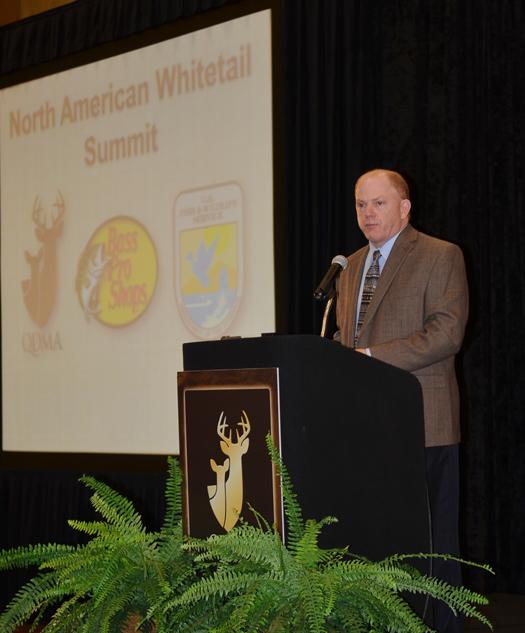
The North American Whitetail Summit is the brainchild of the Quality Deer Management Association (QDMA). Organized to bring together leaders of the whitetail world, the summit is host to conservation organization leadership, biologists from federal and state agencies, hunting industry manufacturers, outdoor media, land managers, concerned hunters and more.
“We are here to identify top priorities of key whitetail stakeholder groups. We are looking for similarities, but also differences. We need to voice concerns, and come together to address them,” said Brian Murphy, CEO of the Quality Deer Management Association.
Understanding that there are significant differences in whitetail deer management desires is key to the success of this summit. Trophy hunters and deer biologists don’t often see eye-to-eye. Land managers and public land hunters have different takes on many topics. But what everyone here really cares about is the white-tailed deer. Working together to shape the future of the North America’s most pursued game animal is both a challenge and privilege.
“We are at a crossroads of whitetail deer management and face more challenges today than in years past. Whitetail deer populations are lower today in many states than they have been in many decades, and hunters are concerned,” Murphy said.
The restoration period of the whitetail plan is all but complete. Deer numbers escalated in many states beyond original expectations set decades ago. Now we must learn to maintain and balance the right number of deer per landscape.
“In many states populations are down 10, 20, 30 percent or more off their peaks. Its how we address these issues that dictates what whitetail deer hunting will look like in years and decades to come,” Murphy said.
The who’s who of this summit is quite impressive. In a video address, Former Vice-Presidential candidate, Congressman Paul Ryan, said, “I am a deer hunter and a land-manager. I am one of you.” _
–Brandon Butler_
